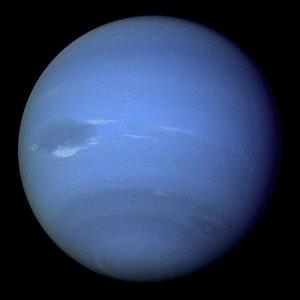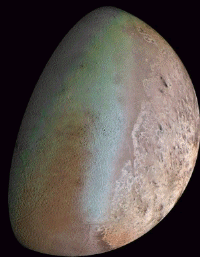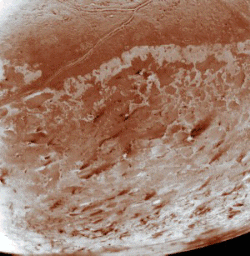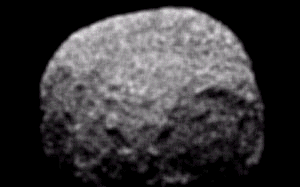
Neptune From Voyager
When Voyager 2 visited Neptune, it was the last planet on its trip. We found out almost all that we know about Neptune and its moons from this brief visit. Notice the large blue oval at the left center, left of the picture. Scientists called this the Great Dark Spot. You can also see white clouds that are above the planet's surface and the faint dark bands at the north and south ends of the planet. The winds on Neptune blow at almost twelve hundred miles per hour.
Neptune is the eighth, or next to last, planet in our solar system. It is located in between Uranus and Pluto. Its average distance from the Sun is almost 2.8 billion (2,800,000,000) miles, or over thirty times the distance from Earth to the Sun. The orbit of Neptune around the Sun is almost a perfect circle. The closest Neptune gets to the Sun is about 2.7 billion miles, and the furthest away it gets is a little over 2.8 billion miles. At this distance, our Sun is just another bright light in Neptune's sky. Since Neptune is so far away from the Sun, it orbits the Sun once every 165 of our Earth years! One day on Neptune is equal to sixteen Earth hours.
As Neptune is no larger than Uranus and is much further away, it will be even harder to see than the blue-green planet. If you have dark skies and a good view to the southern horizon, you may be able to pick it out with your binoculars.
Neptune is about 30 thousand miles in diameter, about four times the size of Earth. Neptune and Uranus are almost the same size, but both seem tiny in comparison to mighty Jupiter, which is almost three times as large as either of them.

Neptune's Faint Rings
All the gas planets in our solar system have rings, and Neptune is no exception. This picture gives us proof that Neptune does indeed have rings, even if they are very dim. The rings are so dim that if you went to Neptune, you would probably not be able to see them. Scientists used computers to make the rings visible in this picture. You can see the three main arcs of the rings, as well as some of the dust. The rings of Neptune are made up of fairly small, very dark clumps of rock. Scientists believe that most of these clumps are about the size of a compact car. Voyager took this picture as it was leaving Neptune, so the Sun is behind the rings, which is what made it possible for us to see them. One of the rings even has a twist in it!
The eight known moon's of Neptune are:
Naiad, Thalassa, Despina, Galatea, Larissa, Proteus, Triton, Nereid

Neptune's Moon Triton
Neptune has eight moons that we know about and there may be more. There are only two that we can see from Earth. One of them is Triton. The family of moons surrounding Neptune is unusual because Triton, the largest, is over 1,600 miles in diameter and the rest of them are tiny, some as small as twenty miles in diameter. Triton is one of the most unusual bodies in our solar system. You will notice that the left half of Triton is smooth, while the right half appears to be very rough. The smooth half is covered by ice, while the right half is a rocky surface. Triton is also the coldest body we know of in the solar system. The temperature on its surface is over four hundred degrees below zero. The black "smudges" you see on the right side of the picture are from the nitrogen geysers that erupt on Triton's surface.

Geysers on Triton
Triton was the last solid object Voyager would see before it left our solar system. As if to save one of the best for last, Voyager sent back this startling picture of Triton. The dark smudges you can see in the surface are actually nitrogen geysers that erupt regularly on the frozen world.

Neptune's Moon Proteus
Almost all of Neptune's eight moons are too small to see from Earth, so what little we do know about them came from the Voyager space mission. Proteus is one of the six moons discovered by Voyager as it flew by Neptune on its way out of the solar system. This tiny moon is only about 250 miles in diameter.
Neptune is named for the Roman god of the sea, but even more interesting is the fact that astronomers were actually looking for it. After William Herschel discovered Uranus, astronomers noticed that its orbit, or path, didn't seem to obey the laws of physics. Something was making Uranus move in unexpected ways. Astronomers decided that there must be another planet making Uranus move and then calculated where the new planet might be. Astronomers Galle and d'Arrest discovered Neptune on September 23, 1846.
Neptune has a small central core, or ball, made of up melted rock. Above the rocky center, the planet is covered by extremely cold water, which eventually changes into the top layer of hydrogen and helium, with a little methane mixed in. The methane is what gives Neptune its color.
Since Neptune is a gas planet, it does not have a solid surface like we do here on Earth. In spite of this, Neptune has some of the most unusual "weather" in the solar system. The winds on Neptune can blow as fast as twelve hundred miles per hour at the planet's equator! The clouds that you see in some of the pictures above are actually frozen water.
Back To Main Menu
Use the "BACK" button on your Browser to return to the previous page.